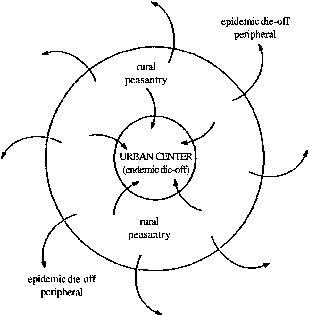
182
Figure 1. Standard mass migration pattern for traditional civilization
Yet these commodities played a critical role in early civilized technology. Trade expeditions, often
205 undistinguishable from raids, were necessary to assure a supply of these and other valued raw materials.
17) This economic motive for penetrating distant regions was supplemented from quite early times by
210 missionary impulses, perhaps sustained by the fact that a missionary preaching some doctrine valued for
religious reasons might also expect to secure for himself an honored and relatively comfortable status
among the barbarian populations who received him and accepted his message. Thus the spread of the so
215 called megalithic tomb and other structures around the coasts of western Europe as far as the Baltic during
the third millennium B.C. seems to have been accomplished by missionaries of a faith that taught life after
death and set great store by accurate astronomical observations.
220 18) Often, too, trade and conversion went hand-in-hand. Merchants and raiders carried idea as well as
goods; and if those ideas somehow illumined reality as experienced by distant and alien peoples among
whom they penetrated, ideational borrowing and adaptation could and did occur in quite the same way that
225 technological traits and skills might also diffuse outward from a civilized center along routes of trade —
always within limits set by the receptivity of the distant community to the imports from the civilized center.
19) Among the skills exported from civilized communities were those of organized violence. As long as
230 human communities did not produce more than was needed to keep alive, raiding and robbery were
relatively unrewarding. Moral inhibitions against seizing what one had not himself labored to make
available for human consumption must, I think, have been very strong in early agricultural communities;
235 and in the absence of food surpluses, a community that tried to live by robbery and pillage would speedily
kill off its victims and thus find itself unable to live any longer by rapine. Only when populations came into
existence that habitually produced more than they themselves consumed did a predatory pattern of life
240 become practicable. And it was only when urban elites had come into being and learned how to feed
themselves by extracting foodstuffs from agriculturalists that populations which habitually produced more
food than they needed for their own use came into existence.
245 20) Eventually, however, dwellers-round-about discovered that they could rival city elites in preying
upon the rural peasantry, seizing food and other commodities on a hit-and-run basis. With luck, a raiding
party could expect to get in ahead of civilized tax and rent collectors or armies living off the countryside.
250 As militarization of the barbarian world proceeded, such raiders became rivals and potential heirs to
civilized ruling classes. In Eurasia, the main reservoir of barbarian prowess established itself on the
grasslands of the steppe, with a secondary center in the drier zone that shades off into desert south of the
steppe.
255
Recorded political history largely turns upon how one wave of barbarian invaders after another coming
off the steppe or in from the deserts of the Middle East and Central Asia conquered civilized lands and
260 established themselves as rulers. Successful conquerors, of course, set out as best they could to prevent
others from following directly in their rear, overthrowing their power. Diplomatic missions, tribute
payments, punitive military expeditions, elaborate border defenseworks to shelter standing armies or,
265 alternatively, local self-defense of civilized landscapes by peasant militias or by professionalized warrior

